If you’ve just had nose filler treatment, it’s important to know what to avoid to ensure the best results and a smooth recovery. Taking care of your newly enhanced nose can make a big difference in how it looks and feels in the days following the procedure.
Here’s a rundown of the key things to steer clear of after your nose filler treatment.
Key Takeaways
- Refrain from touching your nose to avoid complications.
- Avoid makeup for the first 24 hours to let the skin breathe.
- Stay away from intense exercise and heat to reduce swelling.
- Limit alcohol and salty foods to aid in recovery.
- Keep up with follow-up appointments to monitor progress.
Immediate Post-Treatment Care
Right, you’ve just had your nose filler. But the first few hours are key to ensuring you get the best results. Here’s what to keep in mind:
Avoid Touching the Nose
Hands off! It’s tempting to poke and prod, but resist the urge. Your nose is going to be a bit tender, and all that fiddling can actually shift the filler before it’s had a chance to settle properly. Just leave it be.
Refrain from Applying Makeup
I know, I know – you want to cover up any redness or bruising. But hold your horses. Applying makeup immediately after can introduce bacteria to the injection sites, upping your risk of infection.
Plus, the pressure from applying and removing makeup could, again, shift the filler. Give your skin a breather for at least 24 hours, preferably longer if you can.
Do Not Lie Down with Pressure
Try to avoid lying face down or on your side where your nose is pressed against the pillow. This is especially important for the first night. All that pressure can distort the filler while it’s still soft. Sleep on your back if you can, propped up with an extra pillow or two.
Physical Activities to Avoid
Alright, let’s talk about physical activity. You’ve just had nose filler, and while you might be itching to get back to your routine, it’s really important to take it easy for a bit. Overdoing it too soon can affect the filler and your healing process.
Limit Intense Exercise
For the first week or so, avoid any strenuous workouts. I know, it’s a pain, especially if you’re used to hitting the gym hard. But trust me, it’s worth it. Intense exercise increases blood flow, which can worsen swelling and potentially displace the filler.
Stick to light walks or gentle yoga – nothing that gets your heart racing too much.
Avoid Contact Sports
This one’s pretty obvious, but it needs saying. Anything that involves a risk of getting hit in the face is a big no-no. Football, rugby, boxing – put them all on hold.
You don’t want to risk any trauma to the nose while the filler is settling. It’s just not worth the risk. Maybe try something less risky, like chess?
Steer Clear of Hot Environments
Saunas, steam rooms, hot yoga – these are all best avoided in the days following your nose filler treatment. Heat can increase swelling and inflammation, which is exactly what we’re trying to minimise. Plus, excessive heat can sometimes affect the filler itself.
So, keep cool, stay comfortable, and give your nose a chance to heal properly.
Dietary Restrictions
Alright, let’s chat about what you should be eating (and not eating) after getting nose filler. It’s not just about avoiding certain foods; it’s about supporting your body’s healing process. Think of it as giving your nose the best possible environment to settle and look its best. It’s all pretty straightforward, so don’t worry too much!
Reduce Alcohol Consumption
Okay, so this one’s a bit of a downer, but it’s important. Alcohol can thin your blood, which might increase bruising and swelling after your procedure. Try to avoid alcohol for at least 24-48 hours before and after your nose filler treatment.
Avoid Excessive Salt Intake
Salt can cause your body to retain water, which can worsen swelling. I know, it’s in everything! But try to be mindful of your salt intake in the days following your treatment. Read labels, and maybe lay off the crisps for a bit. It’s a small change that can make a difference.
Incorporate Anti-Inflammatory Foods
Load up on foods that fight inflammation. Think berries, leafy greens, fatty fish (like salmon), and nuts. These foods are packed with antioxidants and can help your body heal more efficiently. Plus, they’re delicious! It’s a win-win, really.
Eating well after nose filler isn’t just about avoiding problems; it’s about actively helping your body recover. A balanced diet rich in anti-inflammatory foods can make a noticeable difference in your healing process and overall results. So, treat your body right, and it’ll thank you for it!
Skincare and Hygiene Practises
Use Gentle Cleansers
After getting nose filler, your skin will be a bit sensitive, so you’ll want to be extra careful with it. Avoid anything too harsh or abrasive. Instead, opt for a gentle, fragrance-free cleanser. Using lukewarm water is best – hot water can sometimes irritate the skin further. Pat your face dry with a soft towel instead of rubbing. It’s a small change, but it can make a big difference in how your skin feels.
Avoid Harsh Skincare Products
Right after your nose filler procedure, it’s best to put a pause on any strong skincare products. This means things like retinoids, AHAs/BHAs (chemical exfoliants), and anything with a high concentration of active ingredients. These products can increase sensitivity and potentially cause irritation or inflammation in the treated area.
Give your skin a break for at least a week, or until any initial swelling and redness have subsided. Then, you can slowly reintroduce your regular products, one at a time, to see how your skin reacts.
Do Not Apply Sunscreen Immediately
While sunscreen is usually a must, it’s a good idea to hold off on applying it directly to your nose immediately after getting filler. The pressure from rubbing in sunscreen could potentially disrupt the filler before it has fully settled. Instead, try to avoid direct sun exposure for the first few days.
If you absolutely must be in the sun, wear a wide-brimmed hat for protection. After a couple of days, you can gently apply a mineral-based sunscreen, which tends to be less irritating than chemical sunscreens. Just be sure to use a light touch!
Lifestyle Adjustments for Recovery
Now, let’s talk about some lifestyle tweaks that can really help you sail through the recovery period. It’s all about being kind to your nose and giving it the best chance to settle nicely.
These adjustments are pretty straightforward, and honestly, they can make a world of difference in how you feel and how your results turn out.
Avoid Smoking
Smoking? Yeah, it’s a no-go, especially after getting nose filler. Nicotine messes with blood flow, which can slow down healing and potentially affect the results of your treatment.
Plus, smoking is just generally bad for your skin’s elasticity and overall health. If you can’t quit entirely, at least cut back significantly during the recovery period. Your skin (and your nose) will thank you for it.
Limit Sun Exposure
Okay, so we all love a bit of sunshine, but too much sun exposure can be a problem after nose filler. UV rays can actually break down the filler material faster, which means your results might not last as long. Plus, sunburnt skin around your nose is just not a good look.
So, slap on some sunscreen (once it’s safe to apply, as per your practitioner’s advice), wear a hat, and try to avoid being out in the midday sun. A little bit of shade is your friend right now.
Making these small changes to your daily routine can really help ensure a smooth and successful recovery after your nose filler treatment. It’s all about being patient and giving your body the time it needs to heal properly. And remember, if you have any concerns or questions, don’t hesitate to reach out to your practitioner. They’re there to support you every step of the way!
Monitoring and Follow-Up

After getting nose filler, it’s really important to keep an eye on things and stay in touch with your practitioner. It’s all about making sure you’re happy with the results and that everything is healing as it should. Most people have a smooth recovery, and these steps are just to make sure you’re one of them.
Attend Scheduled Appointments
Make sure you go to all your follow-up appointments. These are usually scheduled a week or two after the procedure, and then again a few months later.
Your practitioner will check how the filler is settling and whether you’re happy with the results. It’s also a good chance to ask any questions you might have. I know life gets busy, but these appointments are worth prioritising.
Communicate Any Concerns
Don’t hesitate to get in touch with your practitioner if you have any worries at all. Whether it’s about swelling, bruising, or just something that doesn’t feel quite right, it’s always better to be safe than sorry.
Early communication can prevent minor issues from becoming bigger problems. It’s what they’re there for, and they’d much rather hear from you than have you worry in silence.
Document Changes in Appearance
It can be really helpful to take photos of your nose at different stages of the healing process. This way, you can track any changes and easily show them to your practitioner if needed. It’s also a good way to see how the filler is settling over time.
I’d suggest taking photos every few days for the first couple of weeks, and then maybe once a week for the next month or so. It’s a simple thing, but it can make a big difference.
Remember, everyone heals at their own pace. If you’re feeling anxious or unsure about anything, reach out to your practitioner. They’re the best people to give you personalised advice and support.
Managing Swelling and Bruising
If you’re noticing a bit of swelling or maybe even a bruise. Don’t panic! It’s pretty normal. Here’s how to handle it:
Apply Ice Packs
Ice is your best mate in the first 24-48 hours. Grab an ice pack (or a bag of frozen peas wrapped in a tea towel – works a treat!), and gently apply it to the area for about 15-20 minutes at a time.
Do this every couple of hours. Just be careful not to apply too much pressure; you don’t want to shift the filler about. I usually just chill on the sofa and watch some telly while I’m doing it.
Stay Hydrated
Hydration is key for, well, pretty much everything, but it’s especially important now. Drink plenty of water. It helps your body heal and can reduce swelling. I find that keeping a water bottle nearby reminds me to keep sipping throughout the day.
Consider Over-the-Counter Remedies
If the swelling or bruising is bothering you, you could consider some over-the-counter options.
Just a heads up, I’m not a doctor, so this isn’t medical advice. Always double-check with your practitioner or a pharmacist before taking anything, especially if you’re already on other medications. They can give you the all-clear and make sure it’s safe for you.
Here’s a quick rundown of what you might consider:
- Arnica Cream: This is a popular choice for bruises. Apply it gently to the affected area, following the instructions on the tube.
- Bromelain Supplements: Some people find that bromelain, an enzyme found in pineapple, helps reduce swelling. Again, check with a professional before taking it.
- Pain Relief: If you’re experiencing discomfort, paracetamol is usually a safe bet. Avoid ibuprofen or aspirin, as they can sometimes increase bruising.
Conclusion
Taking care of your nose after filler treatment is key to achieving the best results. Avoiding certain activities and being mindful of your actions in the days following the procedure can make a big difference. Remember to steer clear of intense exercise, heavy drinking, and touching your nose for at least a week.
It’s all about giving your body the chance to heal properly. If you have any concerns or notice anything unusual, don’t hesitate to reach out to your qualified practitioner. They’re there to help you through the recovery process. With a little patience and care, you’ll be able to enjoy your new look for a long time.
Frequently Asked Questions
What should I avoid doing right after getting nose fillers?
After your nose filler treatment, it’s best to avoid touching your nose, applying makeup, or lying down with pressure on your nose for at least 24 hours.
Can I exercise after having nose fillers?
It’s important to limit intense exercise for the first week after your treatment to prevent swelling and bruising.
What foods should I avoid after getting nose fillers?
Try to reduce alcohol and salt intake, as both can lead to increased swelling. Focus on eating anti-inflammatory foods instead.
How should I care for my skin after nose fillers?
Use gentle cleansers and avoid harsh skincare products. Don’t apply sunscreen immediately after treatment.
Are there any lifestyle changes I should make after nose fillers?
Yes, consider changing your sleeping position to avoid pressure on your nose, and try to limit sun exposure.
How can I manage swelling and bruising after the procedure?
Applying ice packs, staying hydrated, and using over-the-counter remedies can help reduce swelling and bruising.





